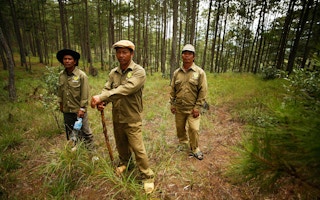The Sustainable Development Goals (SDGs) and their 169 targets are designed as an indivisible and integrated framework for action. In line with these principles, countries are expected to integrate the economic, social, and environmental dimensions of the SDGs into their development processes.
For those in the environmental community, this shift to an integrated approach holds considerable promise: countries will bring environment into the core of their development plans. But there are signs that countries are struggling to integrate the environmental dimensions of the SDGs.
While many countries have made commitments to ensuring environmentally sustainable growth, it has been a challenge to translate them into meaningful action. Recent SDG status reports indicate that implementation of SDGs with a stronger environmental focus show the least progress of all.
Some environment-related SDGs—including SDG 12 on responsible consumption and production and SDG 15 on life on land, both of which are being discussed at this week’s High-Level Political Forum on Sustainable Development—are showing regression. The rhetoric on integration of the environment, dating back to 1972, has tended to outpace the realities of the development process.
“
Policy makers need to better comprehend the impact of their policies on the environment, and the importance of delivering the SDGs as an integrated whole.
Asia and the Pacific arguably has the greatest need to integrate the environmental dimensions of the SDGs. The region currently faces many significant threats to its natural environment, including increasing levels of air and water pollution, high rates of marine and terrestrial biodiversity loss, rising greenhouse gas emissions causing climate change, and rapidly changing production and consumption patterns.
These threats are not only intensifying pressure on Asia-Pacific’s natural resources and ecosystems but are also causing a wide range of adverse impacts upon its populations’ health and well-being. They have likewise begun to undermine the prospects for sustained economic growth and social development within, and even beyond, the region.
ADB is providing technical assistance to help countries identify and then address some of the challenges to integrating the environmental dimensions of the SDGs. A regional stocktaking exercise that drew upon interviews with over 100 policy makers shed light on the previous disconnect between the rhetoric and reality of integration.
Many decision-makers recognise the importance of integrating the environmental dimensions, but nevertheless countries have not moved beyond mapping inter-linkages or piloting approaches that need to be scaled to generate significant impacts. The way forward should involve expanded and deeper integration of the environment into country priorities, so that investment in the environment can be driven domestically and sustained in the long run.
The findings were corroborated at a regional workshop held early this year in collaboration with UNESCAP and UN Environment. The conclusion was that integration of the environment dimensions of the SDGs is already happening in some cases; for example, linking biodiversity corridors with ecotourism in the Greater Mekong Subregion.
But scaling up will require a concerted effort and collaboration among different stakeholders, including governments, civil society, and the private sector. At least three areas for improvement were identified.
The first is institutional and policy coherence. Several ADB developing member countries have mapped the SDGs to ministerial mandates. Central coordinating bodies typically lead these efforts, delegating relevant SDGs to different ministries.
However, the current sector-based approach is not conducive to integration across the thematic issue of environment and should be disrupted, backed up by high-level political support. Multiple ministries must work together and take on the mandate to achieve the environment dimensions of the SDGs, rather than requiring environment ministries to address them on their own.
Policy makers need to better comprehend the impact of their policies on the environment, and the importance of delivering the SDGs as an integrated whole. Screening mechanisms and strategic environmental assessment are important tools for ensuring conflicts and trade-offs are understood and facilitating the reworking of draft policies.
Second, finance for implementation and enforcement, the lack of which is one reason the intentions of environmental policies are not being realised. Environment is not a budget priority in comparison to economic and social issues despite the fact that environment-related SDGs can be a source of revenue growth, particularly SDG 12 which is strongly related to innovation, investment, economic diversity, and growth.
Government and private sector partnerships, supported by appropriate macroeconomic policies that help internalise environmental costs and benefits, can increase investment. Ministries of finance will be key to integration.
Budget tagging and thematic bonds are examples of fiscal policy tools that can help steer development in a greener direction. Governments’ and financial institutions’ understanding of green financing tools, methods, and approaches needs to be strengthened.
The third area to improve on is monitoring and reporting on progress. This is a huge challenge given the vast lack of sufficient and up-to-date baseline data on environmental parameters in almost all ADB developing member countries.
Siloed institutional arrangements and poor coordination between sectors leads to fragmentation of data, no data convergence or verification, inconsistencies with international and national indictors, and a lack of standardised methodologies and sharing systems.
Non-traditional data sources need to be embraced, like using remote sensing to monitor biodiversity losses and gains or community surveys on perceptions of air quality impacts on health in the absence of quantitative data. Capacities must be developed and strengthened so that those responsible for data collation and management can work together and with more innovative data technologies and sources, especially in this age of Big Data.
There is much interest from governments, the private sector, and others to look again at the huge body of experience in tackling environmental issues which can be leveraged to help deliver the SDGs. Moving forward, there is no need to invent new concepts, but rather to use existing tools and methods to help promote more integrated and coordinated approaches to the environment, fitting them to specific national and local realities.
Emma Marsden is a senior environment specialist, Sustainable Development and Climate Change Department, at ADB. This piece was republished with permission from the Asian Development Bank blogs.











